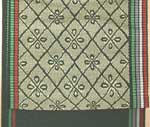Obi
Obi are organized by type, from formal to least formal. Clicking on a photo will take you to a page with more detailed photos and descriptions. Most of my obi are listed (a few remain to be added); the hanhaba obi descriptions aren’t yet online.
Fukuro obi
Colorful, shimmering silver obi, full of different motifs, that goes with my red and black furisode.
Iridescent silver and pastel obi with bubbles and flowing bouquets. Chosen to wear with my hikifurisode and pink tsukesage-houmongi.
One of my favorite pieces. “Chuya” means day and night: this type of obi was used as an alternative to the heavier, brocaded maru obi. One side is brightly patterned, dyed silk – the original background was probably off-white (for “day”), and the reverse side is a gorgeous black and red hakata weave (black for “night”).
Nagoya obi
Shibori camellia and arrow nagoya obi
Completely done in kanoko shibori, this obi’s design of camellia and arrows is appropriate for winter, and especially New Year’s Day.
This is a single-layer (unlined), stiffly woven fukuro Nagoya obi, which borrows characteristics of both fukuro and Nagoya obi (12″ width throughout, but with the shorter length of a Nagoya obi). I bought it to go with my light purple shibori komon, as the diamonds have the same colors in them as the shibori dots in the kimono, and the indigo sets off the light purple kimono beautifully.
Hanhaba obi
Green hakata weave kobukuro obi
Forest green: another of my favorite colors! This obi is formal (yet informal) enough to be worn with a komon; I thought it would look nice with my autumn karabana komon, considering that the colors, geometrical patterns and technique (hakata weave) all make a nice contrast to the kimono’s colors, arabesques and dyeing.
Reversible butterfly hanhaba obi
A hanhaba obi meant to be worn for dance, but that can also be worn with non-dance yukata and komon. This obi is made of polyester rather than silk. After some practice tying, I’ve noticed that polyester and other synthetic fabrics are slippery and harder to tie than silk, although they are easier to take care of.
This rayon obi is sprinkled with cranes throughout. I use it to practice tying hanhaba musubi, although it does go well with my aizome shibori yukata.
last update: 2 January 2006








